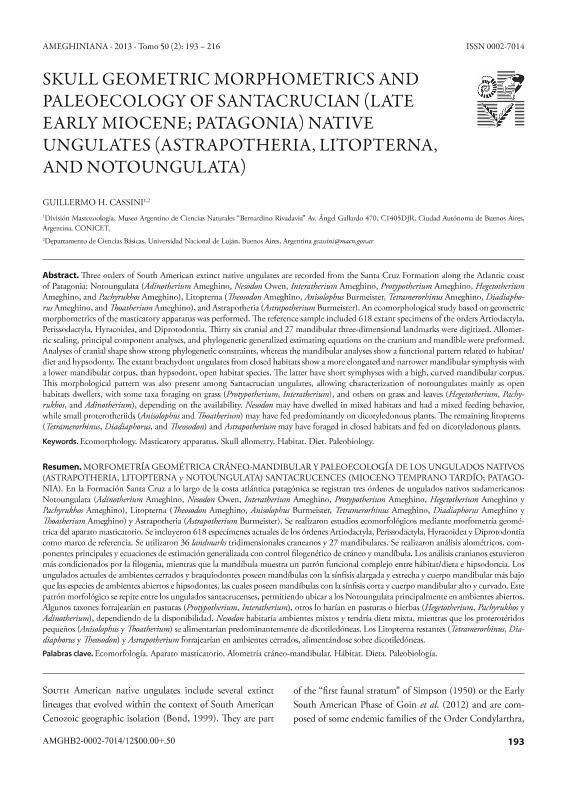Mostrar el registro sencillo del ítem
dc.contributor.author
Cassini, Guillermo Hernán

dc.date.available
2017-10-10T17:17:54Z
dc.date.issued
2013-04
dc.identifier.citation
Cassini, Guillermo Hernán; Skull geometric morphometrics and paleoecology of Santacrucian (late early miocene; Patagonia) native Ungulates (Astrapotheria, Litopterna, and Notoungulata); Asociacion Paleontologica Argentina; Ameghiniana; 50; 2; 4-2013; 193-216
dc.identifier.issn
0002-7014
dc.identifier.uri
http://hdl.handle.net/11336/26393
dc.description.abstract
Three orders of South American extinct native ungulates are recorded from the Santa Cruz Formation along the Atlantic coast of Patagonia: Notoungulata (Adinotherium Ameghino, Nesodon Owen, Interatherium Ameghino, Protypotherium Ameghino, Hegetotherium Ameghino, and Pachyrukhos Ameghino), Litopterna (Theosodon Ameghino, Anisolophus Burmeister, Tetramerorhinus Ameghino, Diadiaphorus Ameghino, and Thoatherium Ameghino), and Astrapotheria (Astrapotherium Burmeister). An ecomorphological study based on geometric morphometrics of the masticatory apparatus was performed. The reference sample included 618 extant specimens of the orders Artiodactyla, Perissodactyla, Hyracoidea, and Diprotodontia. Thirty six cranial and 27 mandibular three-dimensional landmarks were digitized. Allometric scaling, principal component analyses, and phylogenetic generalized estimating equations on the cranium and mandible were preformed. Analyses of cranial shape show strong phylogenetic constraints, whereas the mandibular analyses show a functional pattern related to habitat/ diet and hypsodonty. The extant brachydont ungulates from closed habitats show a more elongated and narrower mandibular symphysis with a lower mandibular corpus, than hypsodont, open habitat species. The latter have short symphyses with a high, curved mandibular corpus. This morphological pattern was also present among Santacrucian ungulates, allowing characterization of notoungulates mainly as open habitats dwellers, with some taxa foraging on grass (Protypotherium, Interatherium), and others on grass and leaves (Hegetotherium, Pachyrukhos, and Adinotherium), depending on the availability. Nesodon may have dwelled in mixed habitats and had a mixed feeding behavior, while small proterotheriids (Anisolophus and Thoatherium) may have fed predominantly on dicotyledonous plants. The remaining litopterns (Tetramerorhinus, Diadiaphorus, and Theosodon) and Astrapotherium may have foraged in closed habitats and fed on dicotyledonous plants.
dc.description.abstract
En la Formación Santa Cruz a lo largo de la costa atlántica patagónica se registran tres órdenes de ungulados nativos sudamericanos: Notoungulata (Adinotherium Ameghino, Nesodon Owen, Interatherium Ameghino, Protypotherium Ameghino, Hegetotherium Ameghino y Pachyrukhos Ameghino), Litopterna (Theosodon Ameghino, Anisolophus Burmeister, Tetramerorhinus Ameghino, Diadiaphorus Ameghino y Thoatherium Ameghino) y Astrapotheria (Astrapotherium Burmeister). Se realizaron estudios ecomorfológicos mediante morfometría geomé- trica del aparato masticatorio. Se incluyeron 618 especímenes actuales de los órdenes Artiodactyla, Perissodactyla, Hyracoidea y Diprotodontia como marco de referencia. Se utilizaron 36 landmarks tridimensionales craneanos y 27 mandibulares. Se realizaron análisis alométricos, componentes principales y ecuaciones de estimación generalizada con control filogenético de cráneo y mandíbula. Los análisis cranianos estuvieron más condicionados por la filogenia, mientras que la mandíbula muestra un patrón funcional complejo entre hábitat/dieta e hipsodoncia. Los ungulados actuales de ambientes cerrados y braquiodontes poseen mandíbulas con la sínfisis alargada y estrecha y cuerpo mandibular más bajo que las especies de ambientes abiertos e hipsodontes, las cuales poseen mandíbulas con la sínfisis corta y cuerpo mandibular alto y curvado. Este patrón morfológico se repite entre los ungulados santacrucenses, permitiendo ubicar a los Notoungulata principalmente en ambientes abiertos. Algunos taxones forrajearían en pasturas (Protypotherium, Interatherium), otros lo harían en pasturas o hierbas (Hegetotherium, Pachyrukhos y Adinotherium), dependiendo de la disponibilidad. Nesodon habitaría ambientes mixtos y tendría dieta mixta, mientras que los proterotéridos pequeños (Anisolophus y Thoatherium) se alimentarían predominantemente de dicotiledóneas. Los Litopterna restantes (Tetramerorhinus, Diadiaphorus y Theosodon) y Astrapotherium forrajearían en ambientes cerrados, alimentándose sobre dicotiledóneas.
dc.format
application/pdf
dc.language.iso
eng
dc.publisher
Asociacion Paleontologica Argentina

dc.rights
info:eu-repo/semantics/openAccess
dc.rights.uri
https://creativecommons.org/licenses/by-nc-sa/2.5/ar/
dc.subject
Ecomorphology
dc.subject
Masticatory Apparatus
dc.subject
Skull Allometry
dc.subject
Habitat
dc.subject
Diet
dc.subject
Paleobiology
dc.subject.classification
Oceanografía, Hidrología, Recursos Hídricos

dc.subject.classification
Ciencias de la Tierra y relacionadas con el Medio Ambiente

dc.subject.classification
CIENCIAS NATURALES Y EXACTAS

dc.title
Skull geometric morphometrics and paleoecology of Santacrucian (late early miocene; Patagonia) native Ungulates (Astrapotheria, Litopterna, and Notoungulata)
dc.title
Morfometría geométrica cráneo-mandibular y paleoecología de los Ungulados nativos (Astrapotheria, Litopterna y Notoungulata) Santacrucences (mioceno temprano tardío; Patagonia)
dc.type
info:eu-repo/semantics/article
dc.type
info:ar-repo/semantics/artículo
dc.type
info:eu-repo/semantics/publishedVersion
dc.date.updated
2015-06-11T21:36:49Z
dc.identifier.eissn
1851-8044
dc.journal.volume
50
dc.journal.number
2
dc.journal.pagination
193-216
dc.journal.pais
Argentina

dc.journal.ciudad
Buenos Aires
dc.description.fil
Fil: Cassini, Guillermo Hernán. Consejo Nacional de Investigaciones Científicas y Técnicas. Oficina de Coordinación Administrativa Parque Centenario. Museo Argentino de Ciencias Naturales "Bernardino Rivadavia"; Argentina. Universidad Nacional de Luján. Departamento de Ciencias Básicas; Argentina
dc.journal.title
Ameghiniana

dc.relation.alternativeid
info:eu-repo/semantics/altIdentifier/url/http://www.ameghiniana.org.ar/index.php/ameghiniana/article/view/606
dc.relation.alternativeid
info:eu-repo/semantics/altIdentifier/doi/http://dx.doi.org/10.5710/AMGH.7.04.2013.606
dc.relation.alternativeid
info:eu-repo/semantics/altIdentifier/url/http://www.bioone.org/doi/abs/10.5710/AMGH.7.04.2013.606
Archivos asociados
